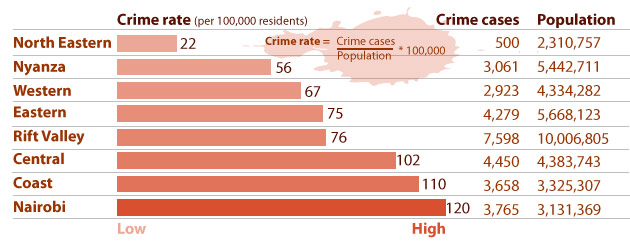People want to read about crime. It sells newspapers and attracts TV and Radio audiences because everyone wants to know how secure they are in their community. In recent opinion polls most Kenyans identified insecurity as one of their biggest concern.
It is therefore not surprising that the release of quarterly crime statistics by the Kenya Police usually gets widespread national media coverage. Indeed that is what happened when the police released crime data for the first quarter of 2013.
The audience expects crime to be reported accurately, but did that happen in this case? In one of the stories in the media The Daily Nation went with the headline Rift Valley tops crimes statistics,The People went with the headline Most dangerous places in Kenya and Police statistics shows crime level down by 10 per cent between January and May was The Standard’s headline.
In its intro The Daily Nation asserted that Rift Valley is the most dangerous province to live in this year while The People reported that Rift Valley, Nairobi and Central provinces are the most dangerous places to live in.
All the three national newspapers said that Western and North Eastern were the safest according to the data.But the reporters and the editors who worked on the stories forgot one thing – The geographical location and population density of the provinces are not the same. They needed to have calculated the crime rate per 100,000 population to determine the most dangerous places. This would have revealed that the likelihood of being a victim of crime is higher in Nairobi, Coast and Central provinces with Rift Valley being number four. One is also more likely to be a victim of crime in Western Kenya than Nyanza with the safest province being Northeastern.
But that would have just been the beginning of the story. More focus should have been on which crimes increased and which ones dropped. In this case The Standard was the worst offender. After going with the headline: Police statistics shows crime level down by 10 per cent between January and May it took until paragraph 11 for the story to say that certain crimes such as murders and rapes had increased. The Daily Nation did slightly better in this regard with the story Murders, robberies on the rise as more police officers linked to crimes.It is interesting that the other dailies did not see it fit to focus on the fact that the number of police officers involved in crime had increased three-fold in the last two years.
Often crime reflects important issues in society such as poverty, unemployment, corruption, drugs and lack of education. There could have been in-depth follow-up stories that explore the deeper issues.To learn how to analyze and find stories in data contact us at: Datadredger@internews.org.


